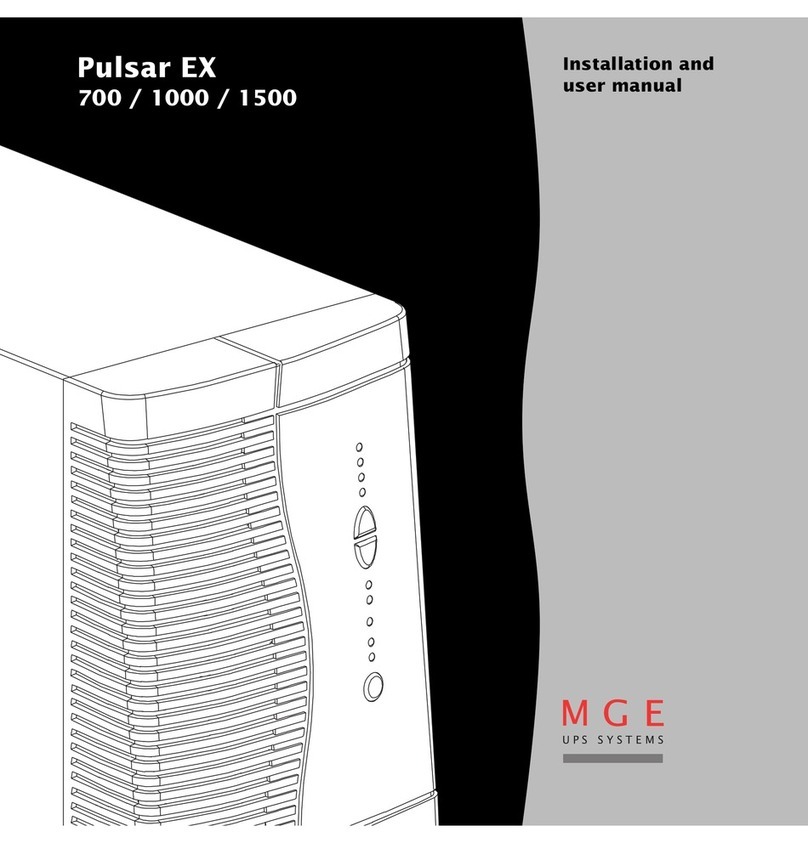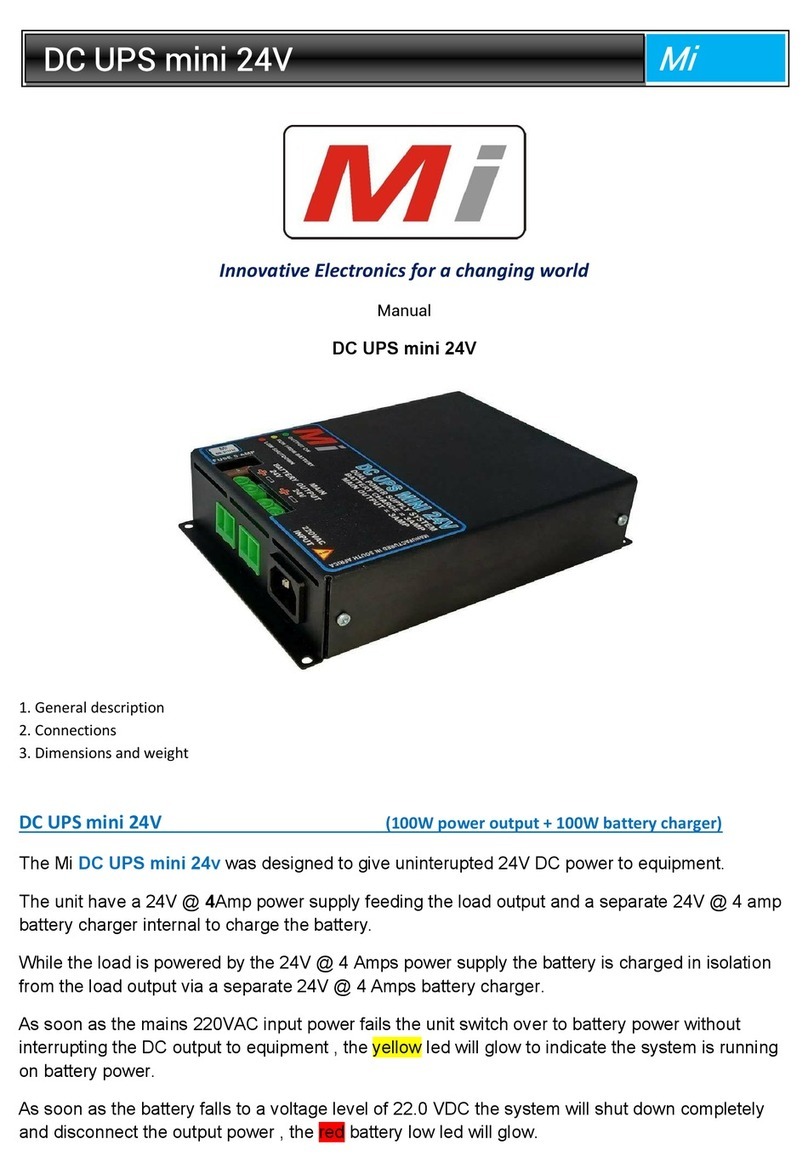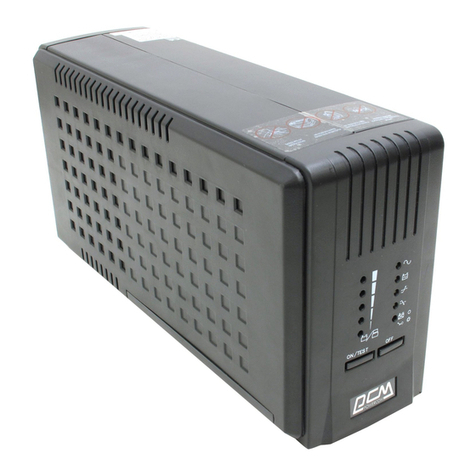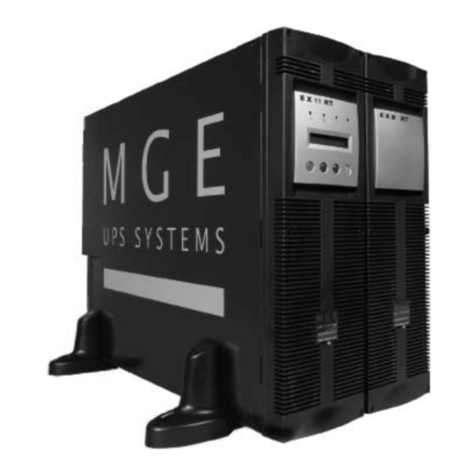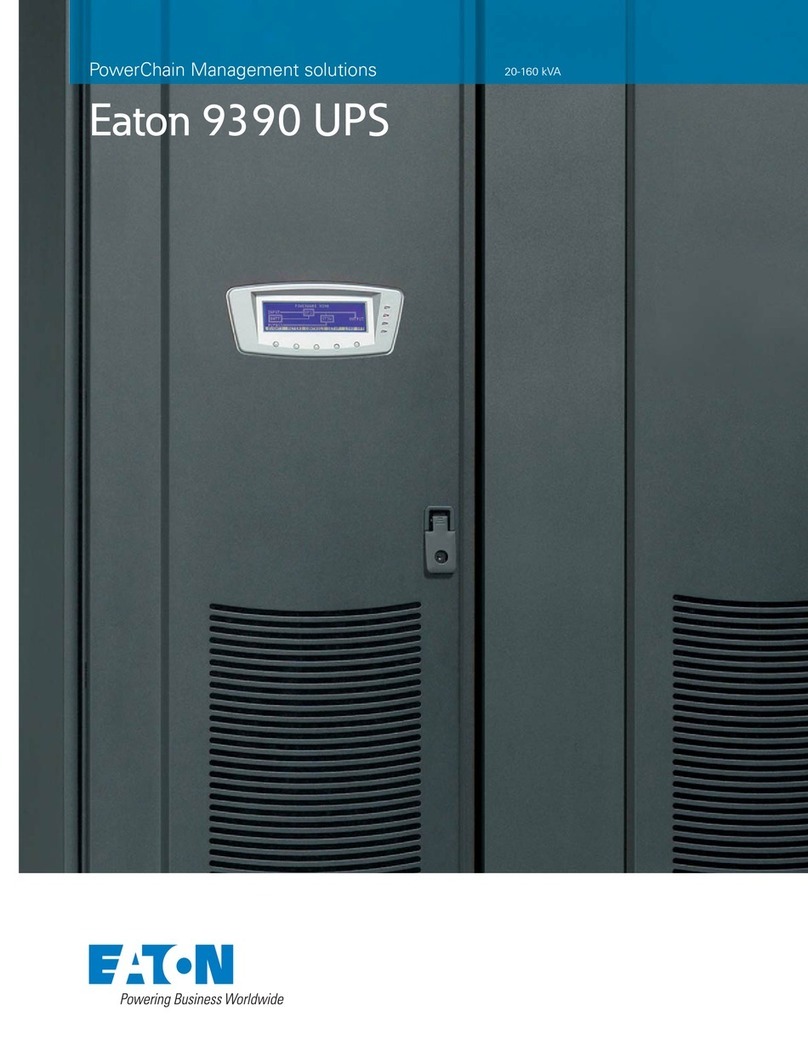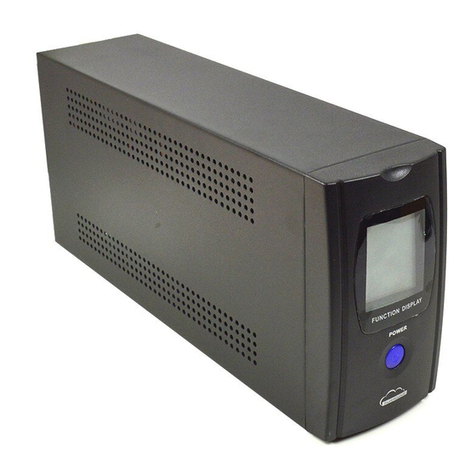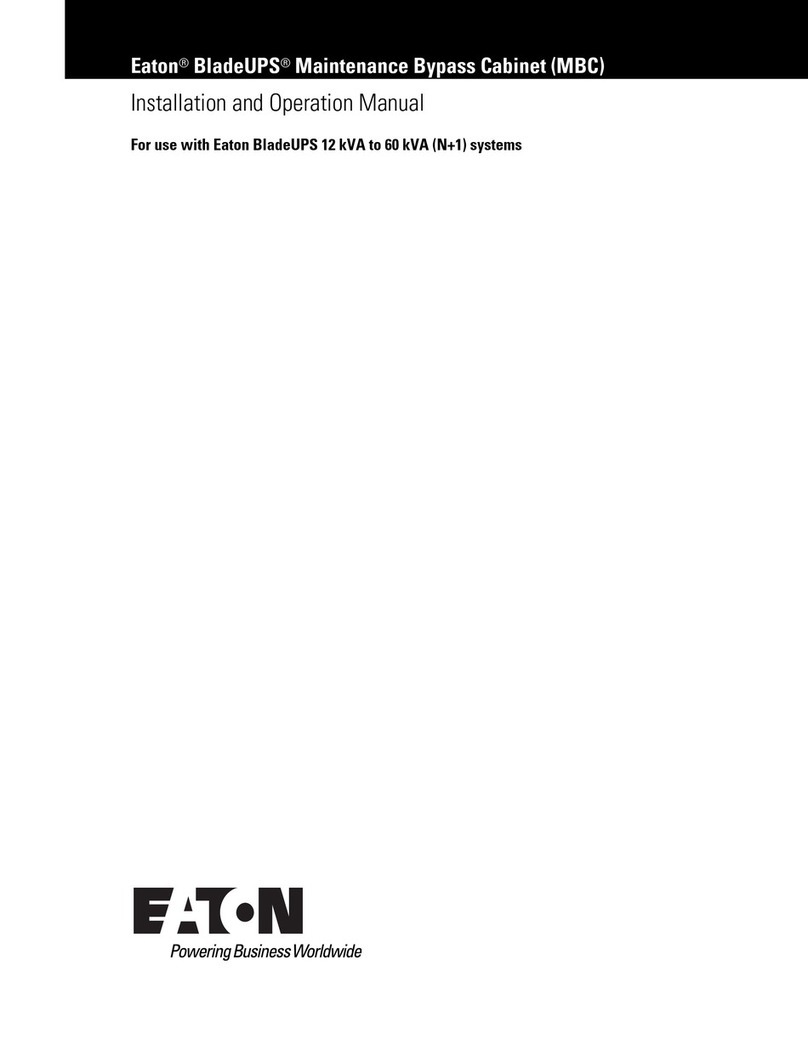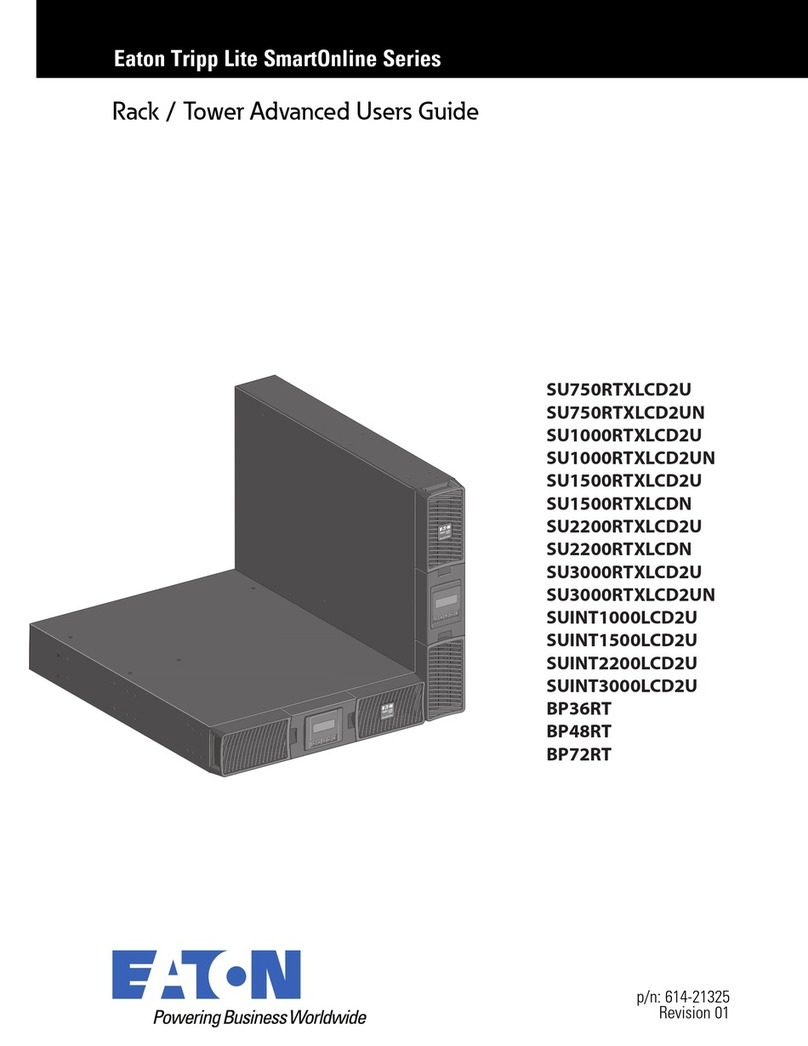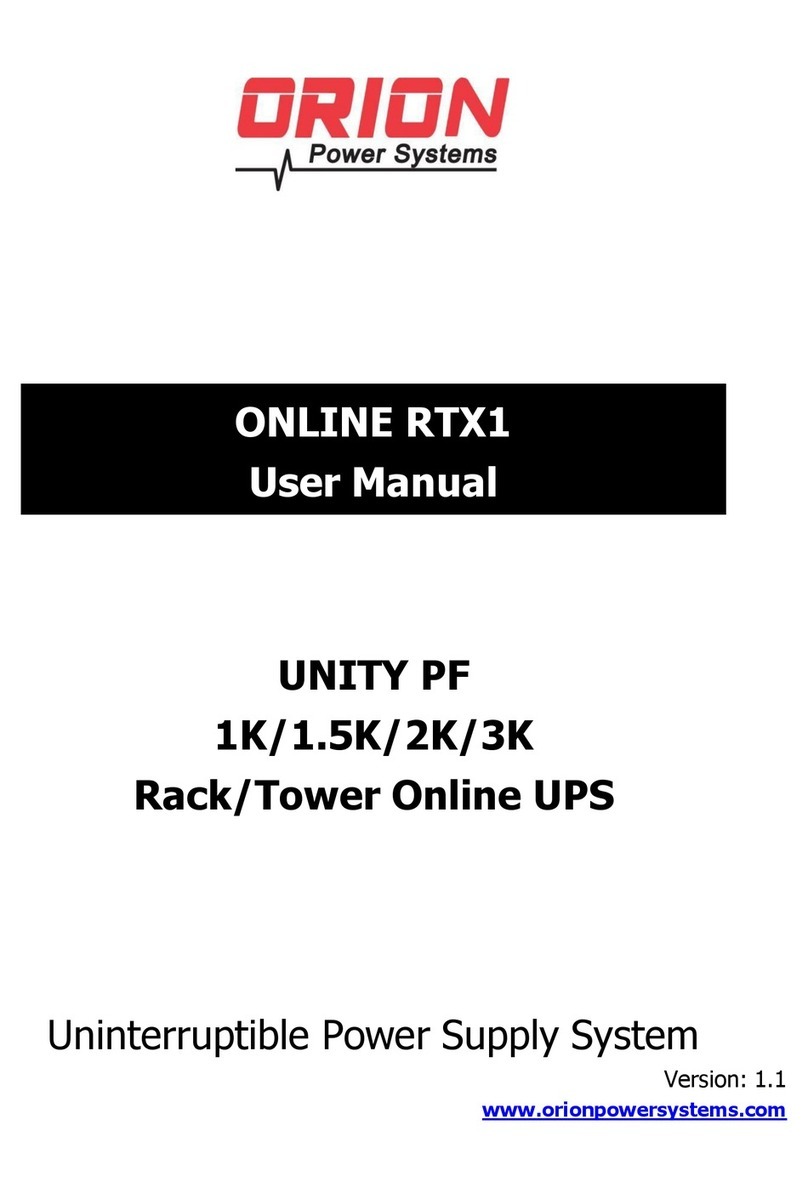Siel SAFEPOWER SPM User manual

IV374E Rev.03
Installation and user manual
Date of issue : 2016-09-06
Page 0 of 63 + FR
800-1280kVA UPS
INSTALLATION AND USER MANUAL
SAFEPOWER SPM
KEEP FOR FUTURE REFERENCE
for the entire life of the appliance


IV374E Rev.03
Installation and user manual
Date of issue : 2016-09-06
Page 1 of 63 + FR
All rights reserved.
The information in this document is subject to change without notice.
Publish statement
Thank you for purchasing this series UPS.
This series UPS is an intelligent, three-phase in three-phase out, high frequency online
UPS supplied to you by a company with years of designing experiences on UPS.
With excellent electrical performance, perfect intelligent monitoring and network
functions, smart appearance, complying with EMC and safety standards, The UPS
meets the world’s advanced level.
Read this manual carefully before installation
This manual provides technical support to the operator of the quipment.

IV374E Rev.03
Installation and user manual
Date of issue : 2016-09-06
Page 2 of 63 + FR
Contents
1.Safety.......................................................................................................................................3
1.1 Safety notes ....................................................................................................................................... 3
1.2 Symbols used in this guide............................................................................................................ 3
2.Main Features........................................................................................................................4
2.1 Summarization................................................................................................................................... 4
2.2 Functions and Features.................................................................................................................. 4
3.Installation..............................................................................................................................5
3.1 Unpack checking .............................................................................................................................. 5
3.2 The appearance of the product..................................................................................................... 5
3.3 UPS module appearance .............................................................................................................. 12
3.4 UPS Module LCD control panel................................................................................................... 13
3.5 Installation notes ............................................................................................................................ 13
3.6 External Protective Devices.......................................................................................................... 14
3.7 Power Cables................................................................................................................................... 14
3.8 Power cable connection................................................................................................................ 15
3.9 Battery connection......................................................................................................................... 16
3.10 Online UPS modules Replacement.......................................................................................... 18
3.11 UPS Multi-Module Installation................................................................................................. 19
3.11.1 Cabinet installation........................................................................................................... 19
3.11.2 Parallel cable installation ................................................................................................ 20
3.12 LBS installation............................................................................................................................. 20
3.12.1 LCD setting........................................................................................................................... 20
3.12.2 LBS cable installation.......................................................................................................... 21
3.12.3 UPS installation.................................................................................................................... 21
4.Operation..............................................................................................................................22
4.1 Operation Modes............................................................................................................................. 22
4.2 Turn on/off UPS............................................................................................................................... 23
4.2.1 Restart procedure................................................................................................................ 23
4.2.2 Test procedure ..................................................................................................................... 24
4.2.3 Cold start procedure........................................................................................................... 24
4.2.4 MAINTENANCE BYPASS ................................................................................................... 25
4.2.5 Shut down procedure......................................................................................................... 26
4.2.6 Startup procedure for parallel system ........................................................................... 26
4.3 The Display....................................................................................................................................... 27
4.3.1 System LCD dispay............................................................................................................. 27
4.3.2 UPS Module LCD display................................................................................................... 35
4.4 Display Messages/Troubleshooting........................................................................................... 41
4.5 Options.............................................................................................................................................. 47
Appendix 1 Specifications.....................................................................................................48
Appendix 2 UPS message table ...........................................................................................50
Appendix 3 Problems and Solution.....................................................................................55
Appendix 4 RS232 communication port definition .........................................................57
Appendix 5 RS485 communication port definition .........................................................58
Appendix 6 BAT_T communication port definition.........................................................59
Appendix 7 Drycontact port definition ...............................................................................60
Appendix 8 REPO instruction...............................................................................................61
Appendix 9 LBS communication port definition..............................................................62

IV374E Rev.03
Installation and user manual
Date of issue : 2016-09-06
Page 3 of 63 + FR
1.Safety
Important safety instructions –Save these instructions
There exists dangerous voltage and high temperature inside the UPS. During the
installation, operation and maintenance, please abide the local safety instructions and relative
laws, otherwise it will result in personnel injury or equipment damage. Safety instructions in this
manual act as a supplementary for the local safety instructions. Our company will not assume the
liability that caused by disobeying safety instructions.
1.1 Safety notes
1.Even no connection with utility power, 220/230/240VAC voltage may still exist at UPS outlet!
2.For the sake of human being safety, please well earth the UPS before starting it.
3.Don’t open or damage battery, for the liquid spilled from the battery is strongly poisonous and
do harmful to body!
4.Please avoid short circuit between anode (+) and cathode (-) of battery, otherwise, it will
cause spark or fire!
5.Don’t disassemble the UPS cover, or there may be an electric shock!
6.Check if there are high voltage, before touching the battery
7.Working environment and storage way will affect the lifetime and reliability of the UPS. Avoid
the UPS from working under following environment for long time
◆Area where the humidity and temperature is out of the specified range(temperature 0
to 40℃, relative humidity 5%-95%)
◆Direct sunlight or location nearby heat
◆Vibration Area with possibility to get the UPS crashed.
◆Area with erosive gas, flammable gas, excessive dust, etc
8.Keep ventilations in good conditions otherwise the components inside the UPS will be
over-heated which may affect the life of the UPS.
1.2 Symbols used in this guide

IV374E Rev.03
Installation and user manual
Date of issue : 2016-09-06
Page 4 of 63 + FR
WARNING!
Risk of electric shock
CAUTION!
Read this information to avoid equipment damage
2.Main Features
2.1 Summarization
Our UPS is a kind of three-in- three -out high frequency online UPS. The product is
modularized and adopt the N+X redundancy. It can flexibly increase the number of the UPS
modules according to the load capacity which is convenient for flexible allocation and gradually
investment.
The UPS can solve most of the power supply problems, such as blackout, over-voltage,
under-voltage, voltage sudden drop, oscillating of decreasing extent, high voltage pulse, voltage
fluctuation, surge, inrush current, harmonic distortion (THD), noise interference, frequency
fluctuation, etc..
This UPS can be applied to different applications from computer device, automatic equipment,
communication system to industry equipment
2.2 Functions and Features
◆Digital control
◆19-inch standard cabinet
2-meter high cabinets are provided according to the user’s requirement.
◆Modularized design
◆High power-density design
The height of the single module is 3U
◆N+X parallel redundancy
This series UPS adopts N+X parallel redundancy design, user can set different redundancy
according to the importance of the load. While the redundancy modules are set more than two,
the availability of UPS system will achieve 99.999%, which may satisfy the required reliability of
the critical load connected. Through LCD display setting, you may configure the required
quantity of the redundancy unit. When the load connected is over the number of the
redundancy, the UPS will alert right away. The design of the MTBF(Meantime before Failure) is
up to 250,000 hours.
This series can set the number of redundancy modules. When the load exceeds the
redundancy setting, the UPS can still work normally and simultaneously send out corresponding
warning as long as the load doesn’t exceed the total capacity of modules.
◆Parallel Redundant control system

IV374E Rev.03
Installation and user manual
Date of issue : 2016-09-06
Page 5 of 63 + FR
◆Optimizing distributed convergence for the cabinet
◆Distributed automatic bypass
◆Common Battery
◆Automatic charge current adjustment according to battery capacity connected.
◆3-Stage Intelligent charging
◆Touch-screen Super-large LCD display
◆Each module with indiviaul LCD display
◆Remote Monitoring via SNMP
◆OptionalAccessories available such as Isolation transformer, Distribution Panel, SNMP Card,
Relay Contact Board, etc..
◆Equip with Maintenance Bypass Switch for easy maintenance purpose.
◆Superior MTTR(Meantime to repair) & Short shutdown time in maintenance
◆Hot-swappable monitoring module
◆EPO and REPO function
3.Installation
3.1 Unpack checking
1. Don’t lean the UPS when moving it out from the packaging
2. Check the appearance to see if the UPS is damaged or not during the transportation, do
not switch on the UPS if any damage found. Please contact the dealer right away.
3. Check the accessories according to the packing list and contact the dealer in case of
missing parts.
3.2 The appearance of the product

IV374E Rev.03
Installation and user manual
Date of issue : 2016-09-06
Page 6 of 63 + FR
800 kVA cabinet
Front View
Front View (No doors)

IV374E Rev.03
Installation and user manual
Date of issue : 2016-09-06
Page 7 of 63 + FR
Rear View (internal)
1. Power cabinet
2. Distribution cabinet
3. Power module:1~20
4. Fuse box : 1~20
5. Bypass choke module
6. Communication module
7. Mains filter capacitor box
8. Mains filter capacitor breaker
9. I/P switch
10. Lightning arrester
11. Bypass filter capacitor box
12. Bypass filter capacitor breaker
13. Bypass switch
14. Switch handle
15. Maintenance switch cover and switch : Remove cover, UPS transfers to maintenance

IV374E Rev.03
Installation and user manual
Date of issue : 2016-09-06
Page 8 of 63 + FR
(*): they are removed in case of separated input mains and bypass terminals
16. Output filter capacitor box
17. Output filter capacitor breaker
18. O/P Switch
19. Mains input phase C copper bar
20. Mains input phase B copper bar
21. Mains input phase A copper bar
22. Bypass input phase C copper bar
23. Bypass input phase B copper bar
24. Input neutral copper bar
25. Bypass input phase A copper bar
26. Output and battery neutral copper bar
27. Battery negative copper bar
28. Battery positive copper bar
29. Output phase C copper bar
30. Output phase B copper bar
31. Output phase A copper bar
32. Mains input copper and bypass input copper connections (*)

IV374E Rev.03
Installation and user manual
Date of issue : 2016-09-06
Page 9 of 63 + FR
1280kVA cabinet
Front View
Front View (No door)

IV374E Rev.03
Installation and user manual
Date of issue : 2016-09-06
Page 10 of 63 + FR
Rear View(internal)
1. Power cabinet
2. Distribution cabinet
3~34: Power module:1~32
35. Communication module
36. I/P Switch
37. Bypass Switch
38. Maintenance switch
39. Maintenance switch cover : Remove cover, UPS transfers to maintenance
40. O/P Switch
41~72. Fuse box : 1~32
73. Mains input phase A copper bar
74. Mains input phase B copper bar
75. Mains input phase C copper bar
76. Bypass input phase A copper bar
77. Bypass input phase B copper bar
78. Bypass input phase C copper bar
79. Output and battery neutral copper bar

IV374E Rev.03
Installation and user manual
Date of issue : 2016-09-06
Page 11 of 63 + FR
Note: there are bars to be removed in case of separated input mains and bypass terminals
Communication panel
80. Input neutral copper
81. Output phase A copper bar
82. Output phase B copper bar
83. Output phase C copper bar
84. Battery positive copper bar
85. Battery negative copper bar
86. Grounding
87. Battery negative copper bar
88. Battery positive copper bar
89. Grounding
(1) Communication panel fixed screw
(2) Intelligent slot 1 : insert SNMP card or Dry contact card
(3) Intelligent slot 2 : insert SNMP card or Dry contact card
(4) RS485 port 1/2
(5) BAT_T port 1/2 : connect battery temperature sensor box
(6) Dry contact : Pin1- BP_S, Pin2- BP_O, Pin7- DRY_GENER, Pin8-12Vdc
(7) RS232 port
(8) EPO button
(9) REPO port : Remote EPO connect port
(10) LED indications
(11) Function keys
(12) LCD port : connected to LCD panel

IV374E Rev.03
Installation and user manual
Date of issue : 2016-09-06
Page 12 of 63 + FR
3.3 UPS module appearance
Front View
Rear View
Side View
(1) Module left switch screw
(2) Module right switch screw
(3) Module fixed screw
(4) handle
(5) LCD display
(6) INV fan
(7) PFC fan
(8) Module output connector slot

IV374E Rev.03
Installation and user manual
Date of issue : 2016-09-06
Page 13 of 63 + FR
(9) Module input connector slot
3.4 UPS Module LCD control panel
LCD control panel introduction
(1) LED(from top to bottom: “alarm”, “bypass mode”, “battery mode”, “mains mode”)
(2) LCD display
(3) scroll button
(4) Off button
(5) On button
3.5 Installation notes
Note: Consider for the convenience of operation and maintenance, the space in
front and back of the cabinet should be left at least 100cm and 80cm respectively when
installing the cabinet .
◆Please place the UPS in a clean, stable environment, avoid the vibration, dust, humidity,
flammable gas and liquid, corrosive. To avoid from high room temperature, a system of room
extractor fans is recommended to be installed. Air filters are available at the front grills, to be
periodically mainteined if the UPS operates in a dusty environment.
◆The environment temperature around UPS should keep in a range of 0°C~40°C. If the
environment temperature exceeds 40°C, the rated load capacity should be reduced by 12%per
5°C. The max temperature can't be higher than 50°C.
◆If the UPS is postioned at low temperature, it might be in a condensing condition.The UPS
can't be installed unless the internal and external of the equipment is fully dry. Otherwise, there will
be in danger of electric shock.
◆Batteries should be mounted in an environment where the temperature is within the required
specs. Temperature is a major factor in determining battery life and capacity. In a normal
installation, the battery temperature is maintained between 15°C and 25°C. Keep batteries away
from heat sources or main air ventilation area, etc.

IV374E Rev.03
Installation and user manual
Date of issue : 2016-09-06
Page 14 of 63 + FR
WARNING!
Typical battery performance data are quoted for an operating temperature between
20°C and 25°C. Operating it above this range will reduce the battery life while
operation below this range will reduce the battery capacity.
◆Should the equipment not be installed immediately it must be stored in a room so as to
protect it against excessive humidity and or heat sources.
CAUTION!
An unused battery must be recharged every 6months Temporarily connecting the
UPS to a suitable AC supply mains and activating it for the time required for
recharging the batteries.
◆The highest altitude that UPS may work normally with full load is 1500 meters. The load
capacity should be reduced when this UPS is installed in place whose altitude is higher than 1500
meters, shown as the following table:
(Load coefficient equals max load in high altitude place divided by nominal power of the UPS)
Altitude(m)
1500
2000
2500
3000
3500
4000
4500
5000
Load coefficient
100%
95%
90%
85%
80%
75%
70%
65%
◆The UPS cooling is depending on fan, so it should be kept in good air ventilation area.
There are many ventilation holes on the front and rear, so they should not be blocked by any exotic
obstacles.
3.6 External Protective Devices
For safety reasons, it is necessary to install, external circuit switch at the input A.C. supply
and the battery. This chapter provides guidelines for qualified installers that must have the
knowledge of local wiring practices for the equipment to be installed.
◆External Battery
The UPS and its associated batteries are protected against the effect of over-current
through a DC compatible thermo-magnetic circuit-switch (or a set of fuses) located close
to the battery.
◆UPS Output
Any external distribution board used for load distribution shall be fitted with protective
devices that may avoid the risk of UPS overloaded.
◆Over-current
Protection device shall be installed at the distribution panel of the incoming main
supply. It may identify the power cables current capacity as well as the overload capacity
of the system .
3.7 Power Cables
◆The cable design shall comply with the voltages and currents provided in this section. Kindly
follow local wiring practices and take into consideration the environmental conditions

IV374E Rev.03
Installation and user manual
Date of issue : 2016-09-06
Page 15 of 63 + FR
(temperature and physical support means) .
WARNING!
UPON STARTING, PLEASE ENSURE THAT YOU ARE AWARE OF THE
LOCATION AND OPERATION OF THE EXTERNAL ISOLATORS WHICH ARE
CONNECTED TO THE UPS INPUT/BYPASS SUPPLY OF THE MAINS
DISTRIBUTION PANEL. CHECK TO SEE IF THESE SUPPLIES ARE
ELECTRICALLY ISOLATED, AND POST ANY NECESSARY WARNING SIGNS TO
PREVENT ANY INADVERTENT OPERATION
◆For future expansion purpose, it is advisable to install power cable according to the full rating
capacity initially. The diameter of cables per each phase/pole is shown below:
UPS
cabinet
Cable Dimension
AC Input
(mm2)
AC Output
(mm2)
DC Input
(mm2)
Grounding
(mm2)
800
185*3
185*3
240*4
185*3
1280
240*4
240*4
240*6
240*4
CAUTION!
Protective earth cable: Connect each cabinet to the main ground system. For
Grounding connection, follow the shortest route possible.
WARNING!
FAILURE TO FOLLOW ADEQUATE EARTHING PROCEDURES MAY
RESULT IN ELECTROMAGNETIC INTERFERENCE OR IN HAZARDS
INVOLVING ELECTRIC SHOCK AND FIRE
3.8 Power cable connection
Before installing the equipment, it is necessary to verify the type of input source, that is, if there is
a single or a dual input. In case of dual input, verify the copper bars that connecting bypass and
mains input (rectifier) have been removed.
Once the equipment has been finally positioned and secured, connect the power cables as
described in the following procedure.
Verify the UPS is totally isolated from its external power source and also all power isolators of the
UPS are open. Check to see if they are electrically isolated, and post any necessary warning signs to
prevent their inadvertent operation.
Remove the distribution rear cover. Choose appropriate power cables (refer to the table above
reported) and pay attention to the diameter of the connection terminal of the cable that should be
greater than or equal to that of the connection poles;
Wiring

IV374E Rev.03
Installation and user manual
Date of issue : 2016-09-06
Page 16 of 63 + FR
WARNING!
If the load equipment is not ready to accept power on the arrival of the
commissioning engineer then ensure that the system output cables are
safely isolated at their ends
Connect the safety earth and any necessary bonding earth cables to
the copper earth screw bar located on the bottom of the equipment below
the power connections. All cabinets in the UPS must be grounded
properly.
CAUTION!
The earthing and neutral bonding arrangement must be in accordance
with local and national codes of practice.
3.9 Battery connection
The UPS adopts positive and negative double battery framework, total 40 (optional 32/34/36/38)
in series.Aneutral cable is retrieved from the joint between the cathode of the 20th (16th/17th/18th/19th)
and the anode of the 21st (17th/18th/19th/20th) of the batteries. Then the neutral cable, the battery
positive and the battery negative are connected with the UPS respectively. The battery sets between
the battery anode (+) and the neutral are called positive batteries and that between neutral and
cathode (-) are called negative ones. The user can choose the capacity and the numbers of the
batteries according to their desire.

IV374E Rev.03
Installation and user manual
Date of issue : 2016-09-06
Page 17 of 63 + FR
Note:
The BAT+ of the UPS connect poles is connected to the anode (+) of the
positive battery, the BAT-N is connected to the cathode (-) of the positive battery and
the anode of the negative battery, the BAT- is connected to the cathode of the
negative battery.
Factory setting of the long-run unit is battery quantity 40pcs, battery capacity
12V xxAh. When connecting 32/34/36/38 batteries, please re-set desired battery
quantity and its capacity after UPS starts at AC mode. Charger current could be
adjusted automatically according to battery capacity selected. All related settings can
be done through LCD panel or monitoring software.
CAUTION!
Ensure correct polarity battery string series connection. i.e. inter-tier and inter
block connections are from (+) to (-)terminals.
Don’t mix batteries with different capacity or different brands, or even mix up
new and old batteries, either.
WARNING!
Ensure correct polarity of string end connections to the Battery Circuit Switch
and from the Battery Circuit Switch to the UPS terminals i.e. (+) to (+) / (-) to (-) but
disconnect one or more battery cell links in each tier. Do not reconnect these links
and do not close the battery circuit switch unless authorized by the commissioning
engineer.

IV374E Rev.03
Installation and user manual
Date of issue : 2016-09-06
Page 18 of 63 + FR
3.10 Online UPS modules Replacement
For the UPS, modules must be inserted to make a complete UPS system.
The replacement of UPS module is very simple and can be operated online.The control
system of the UPS can detect the inserted or removed module(s) automatically. The user may
operate easily by following the steps mentioned below.
◆NOTE: The UPS module is rather heavy, please move it by two people!
◆Insert module
(1) Remove decorated panel;
(2) Put the UPS module in the cabinet module slot. Push the module along the slot into the
cabinet until the module is inserted properly.
(3) Fix the module with screws (M5) at the positioning screw holes;
(4) Switch on the bypass switch,mains switch and output switch accordingly.
(5) After the modules start up , the system will detect the modules inserted automatically,
and parallel up the modules into whole system.
◆Remove UPS module
Remove the coronal screws on the left side of the module to stop the module running
completely and remove the module after fan stop spinning.
WARNING!
(1) Make sure the LCD screen is totally off before removing the module; otherwise, electric sparks will
occur at the connection of module and system cabinet.
(2) The coronal screw at left side or rignt side of the module controls the operation of the module.
Only after the screw is tightened, the module can start running. When insert new module, make sure
the screw is tightened properly.
(3) When insert the module under battery mode, please press “ON”button at module’s LCD panel
Table of contents
Other Siel UPS manuals

Siel
Siel Safepower Evo 20 User manual
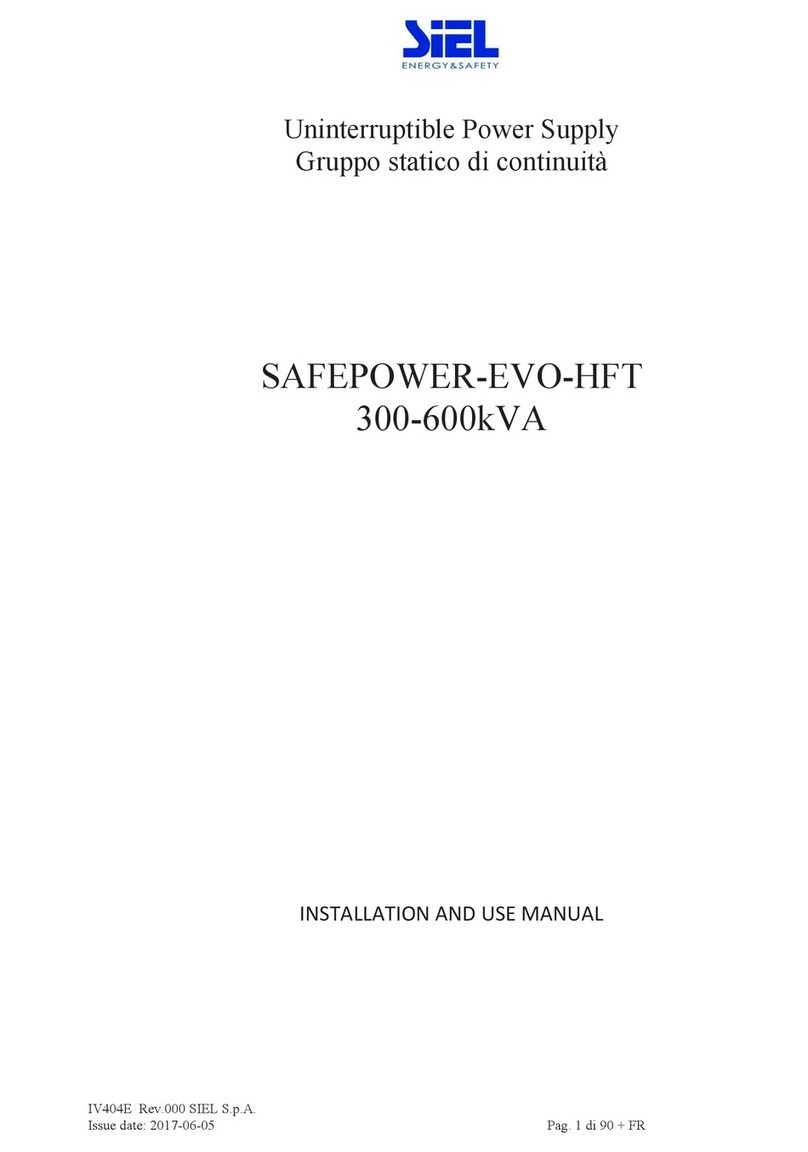
Siel
Siel SAFEPOWER EVO HFT Guide
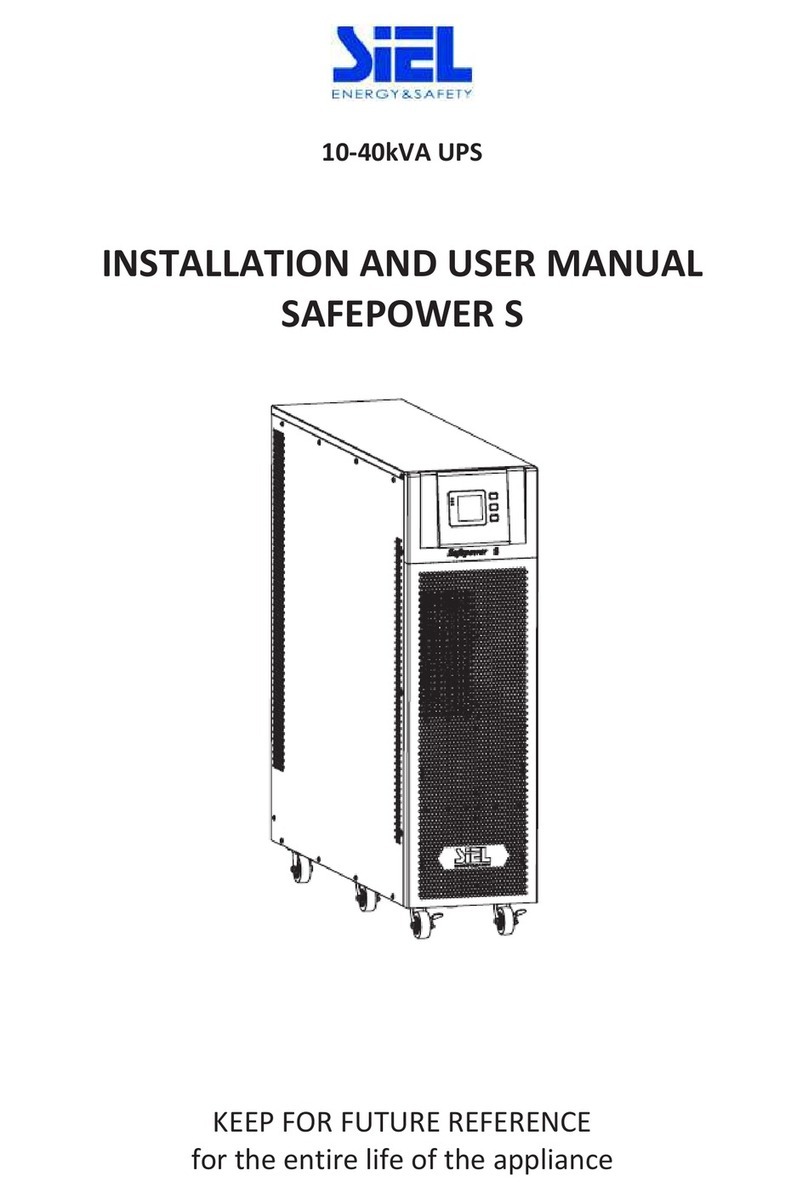
Siel
Siel SAFEPOWER S User manual
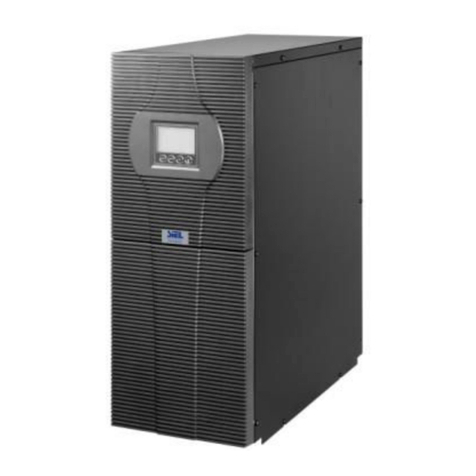
Siel
Siel Green Point 6 20KVA User manual

Siel
Siel 6kVA User manual
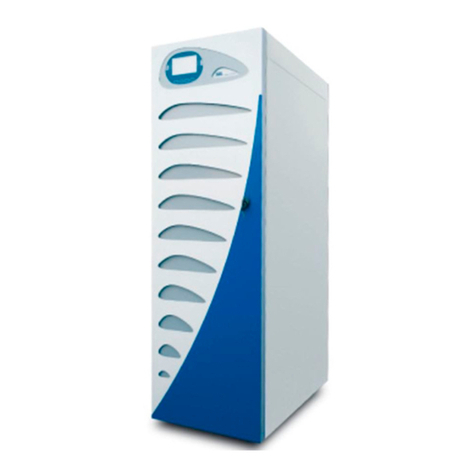
Siel
Siel SAFEPOWER-EVO-HF Series User manual
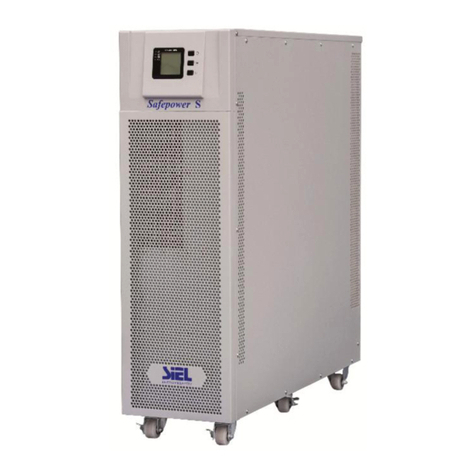
Siel
Siel SAFEPOWER S series User manual
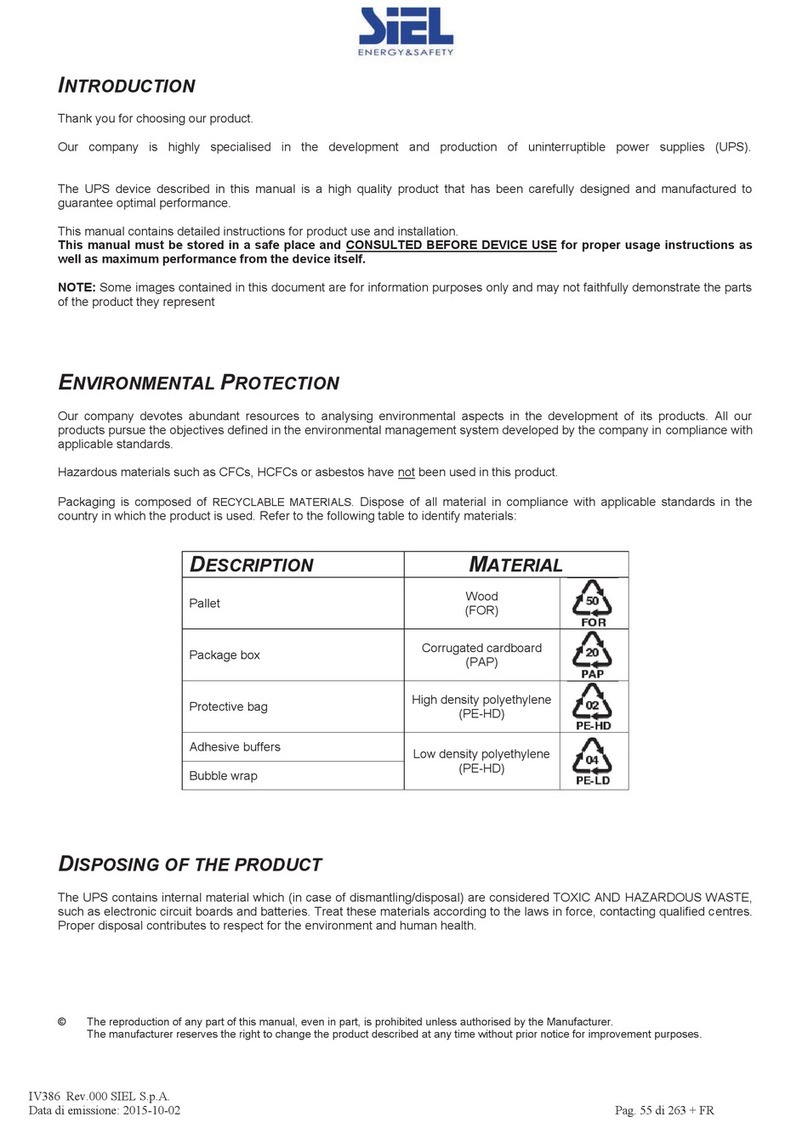
Siel
Siel SAFEPOWER EVO-HF 200 Guide

Siel
Siel SAFEPOWER S User manual
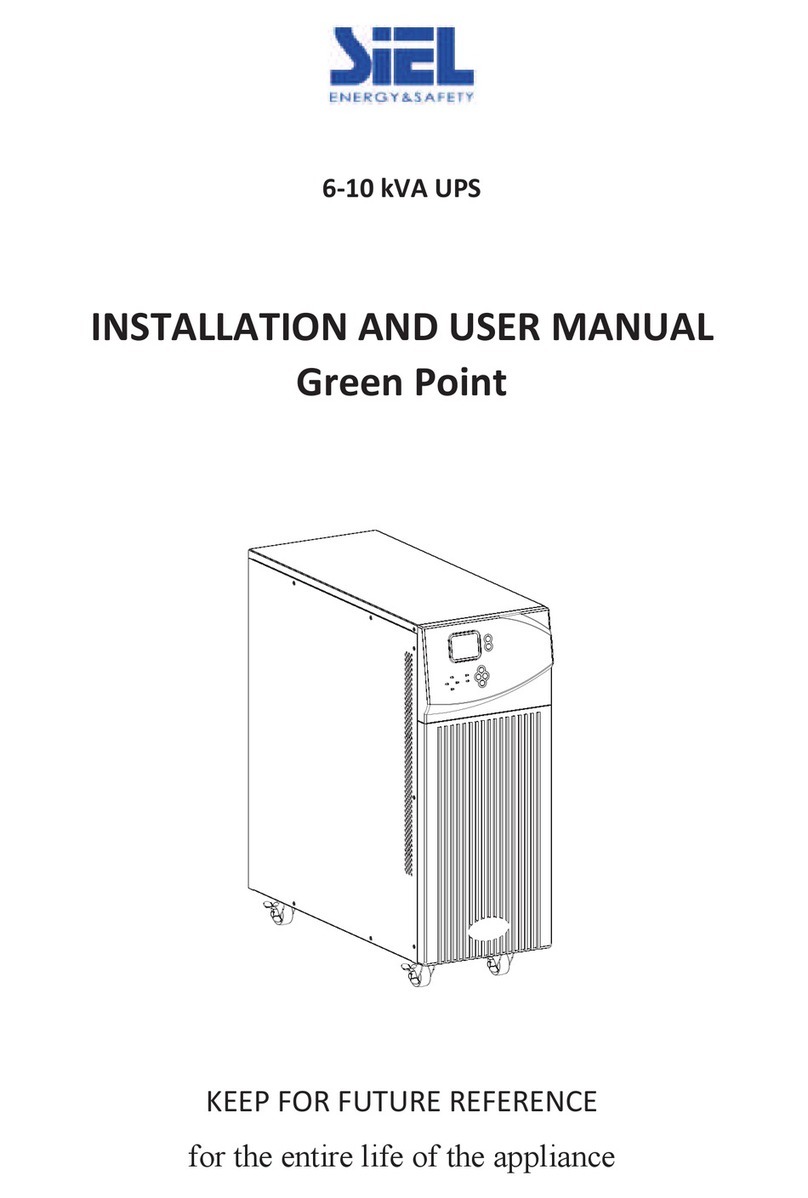
Siel
Siel Green Point User manual
Popular UPS manuals by other brands
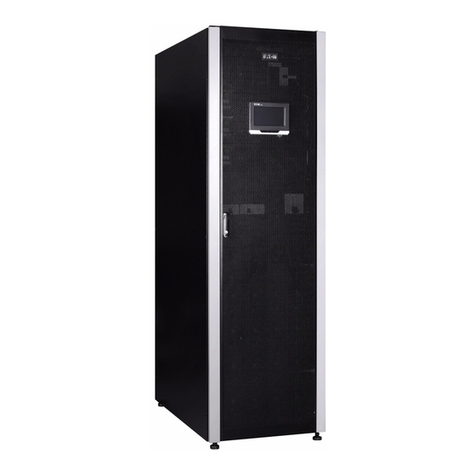
Eaton
Eaton 93PR Series User and installation guide
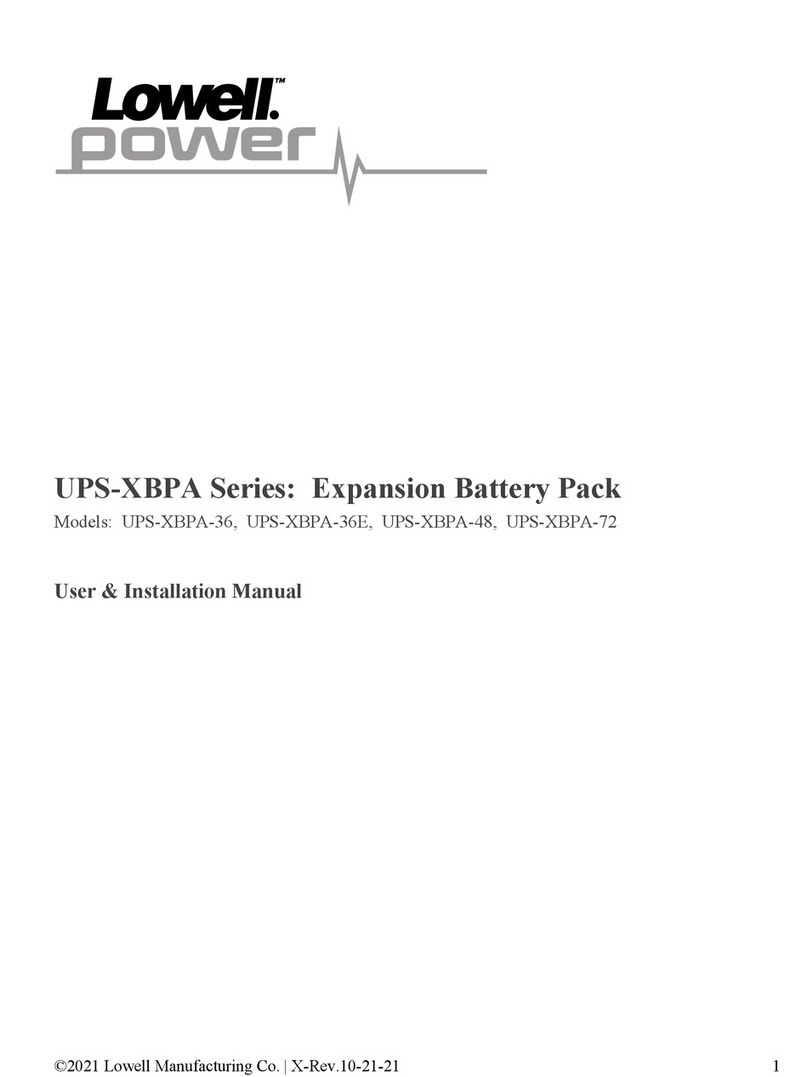
Lowell power
Lowell power UPS-XBPA Series User & installation manual
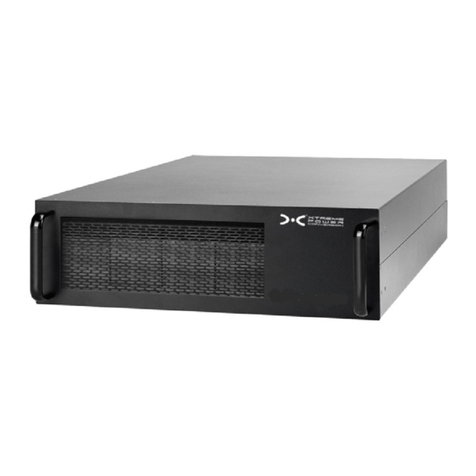
Xtreme Power Conversion
Xtreme Power Conversion NXRi-6KL User & installation manual
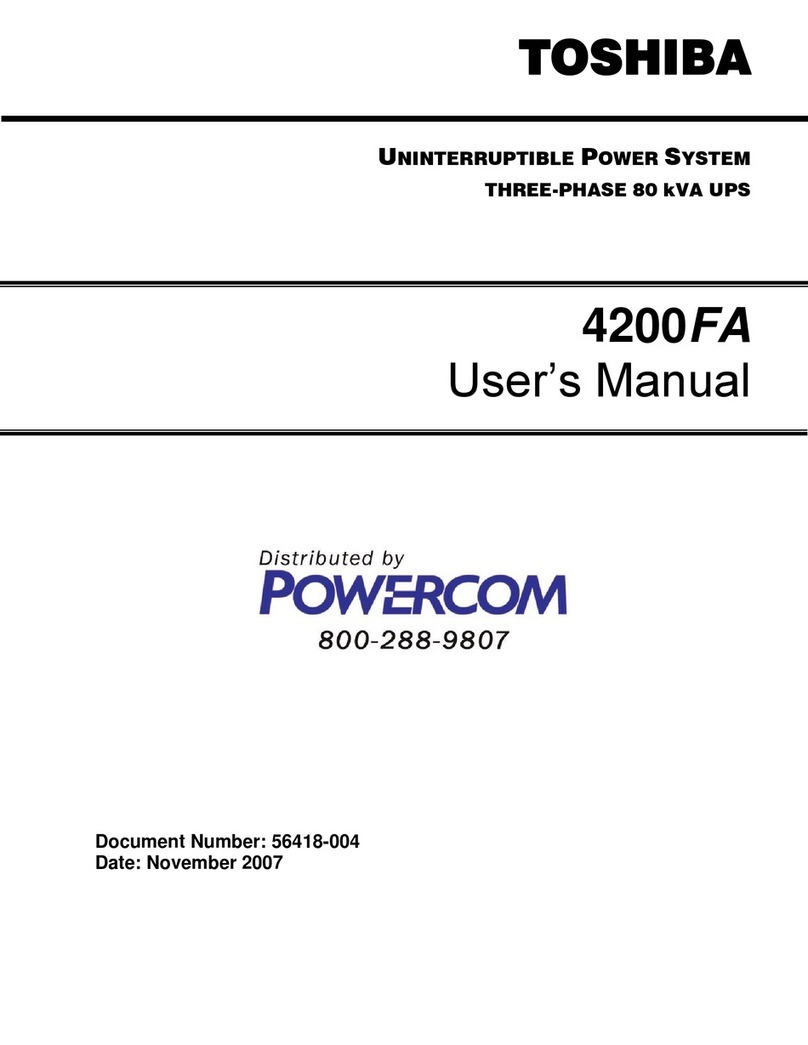
Toshiba
Toshiba 4200FA Series user manual
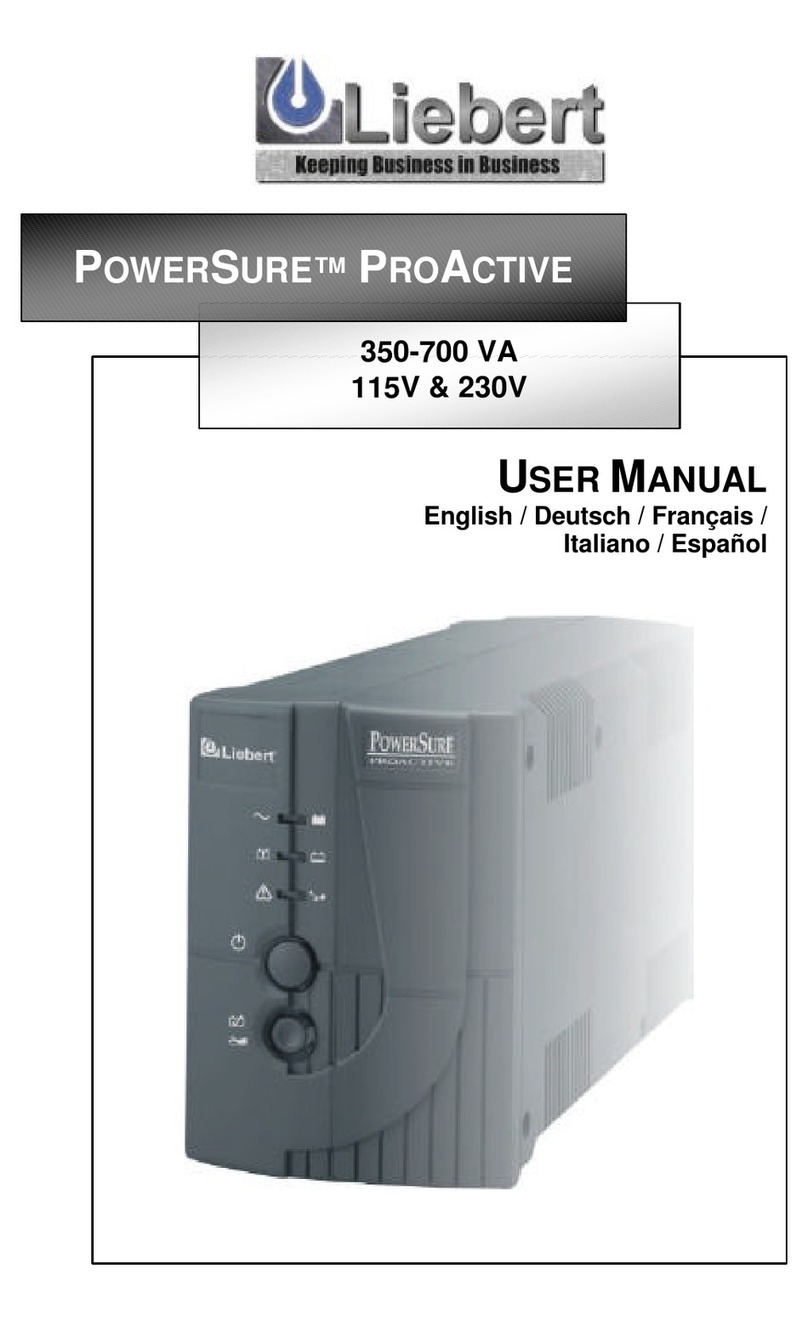
Liebert
Liebert 115V user manual
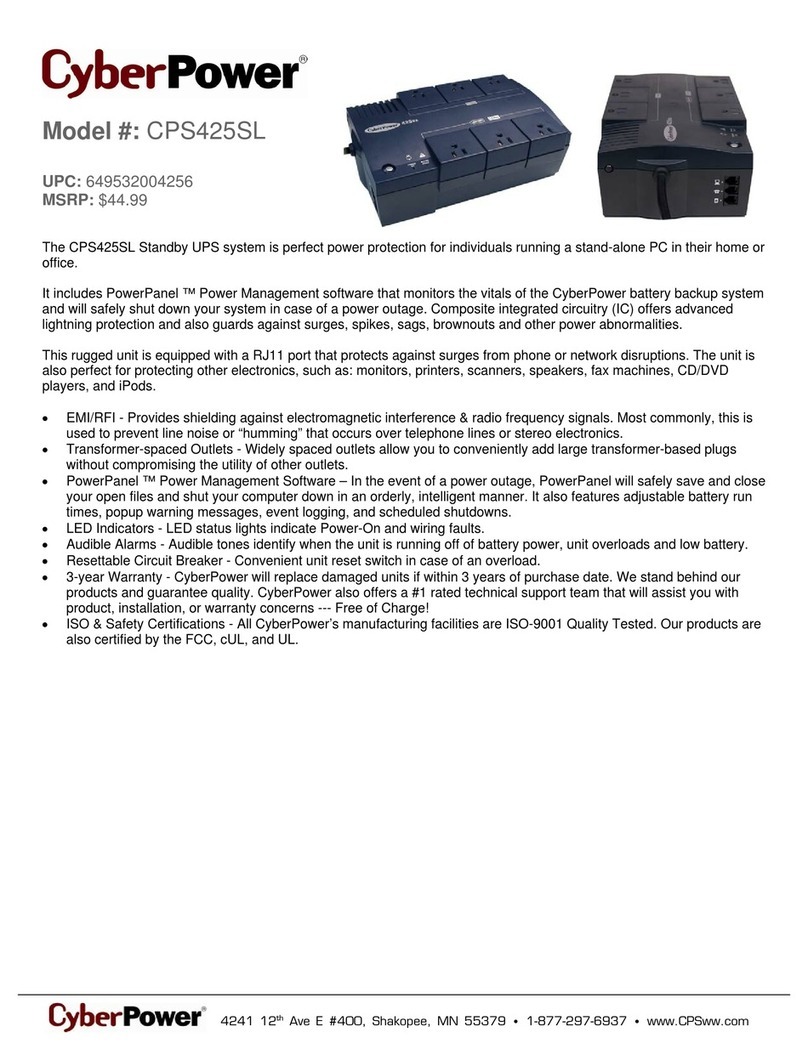
CyberPower
CyberPower 649532004256 Specification sheet


